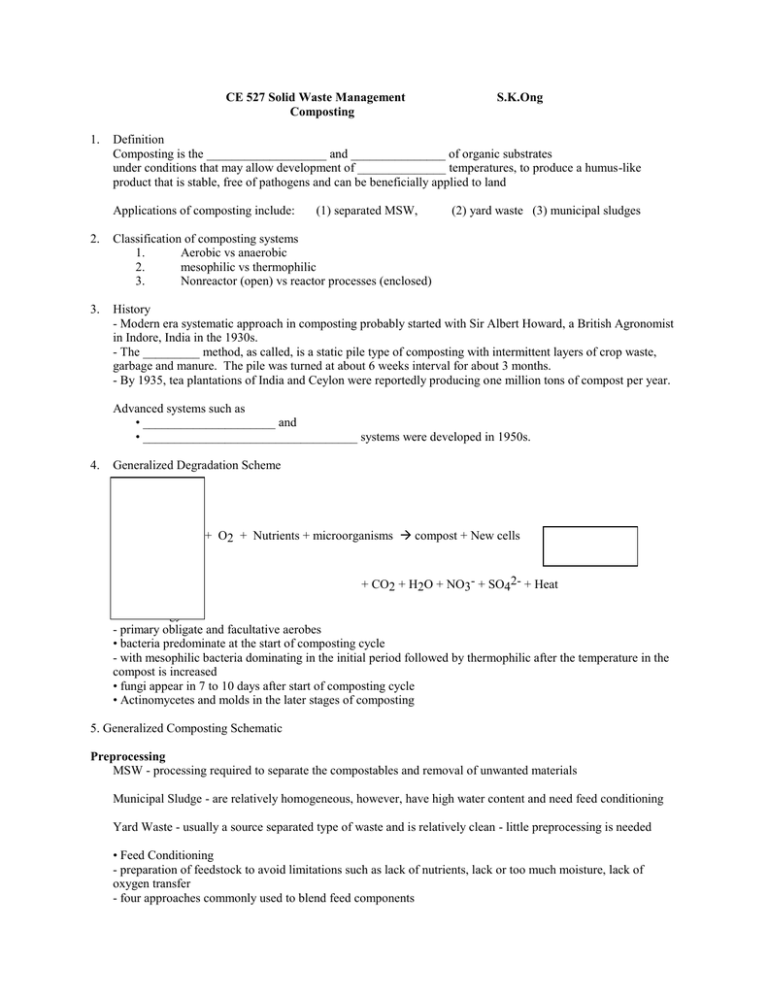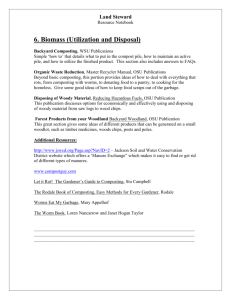1. Definition
advertisement

CE 527 Solid Waste Management Composting 1. S.K.Ong Definition Composting is the ___________________ and _______________ of organic substrates under conditions that may allow development of ______________ temperatures, to produce a humus-like product that is stable, free of pathogens and can be beneficially applied to land Applications of composting include: (1) separated MSW, (2) yard waste (3) municipal sludges 2. Classification of composting systems 1. Aerobic vs anaerobic 2. mesophilic vs thermophilic 3. Nonreactor (open) vs reactor processes (enclosed) 3. History - Modern era systematic approach in composting probably started with Sir Albert Howard, a British Agronomist in Indore, India in the 1930s. - The _________ method, as called, is a static pile type of composting with intermittent layers of crop waste, garbage and manure. The pile was turned at about 6 weeks interval for about 3 months. - By 1935, tea plantations of India and Ceylon were reportedly producing one million tons of compost per year. Advanced systems such as • _____________________ and • __________________________________ systems were developed in 1950s. 4. Generalized Degradation Scheme Proteins Amino Acids Lipids Carbohydrates Cellulose Lignin Ash + O2 + Nutrients + microorganisms compost + New cells + CO2 + H2O + NO3- + SO42- + Heat Microbiology - primary obligate and facultative aerobes • bacteria predominate at the start of composting cycle - with mesophilic bacteria dominating in the initial period followed by thermophilic after the temperature in the compost is increased • fungi appear in 7 to 10 days after start of composting cycle • Actinomycetes and molds in the later stages of composting 5. Generalized Composting Schematic Preprocessing MSW - processing required to separate the compostables and removal of unwanted materials Municipal Sludge - are relatively homogeneous, however, have high water content and need feed conditioning Yard Waste - usually a source separated type of waste and is relatively clean - little preprocessing is needed • Feed Conditioning - preparation of feedstock to avoid limitations such as lack of nutrients, lack or too much moisture, lack of oxygen transfer - four approaches commonly used to blend feed components (1) recycle compost product and blending with other feed components (2) addition of organic and/or inorganic amendments (3) addition of bulking agent such as wood chips and subsequent screening of the bulking particles from the compost product (4) combination of the above Amendment - material added to condition feed mixture for structural or drying purposes, i.e., reduce bulk weight and increase void spaces and energy or fuel purposes i.e., to increase the quantity of biodegradable organics and thereby the energy content of the mixture Examples - sawdust rice hulls, yard wastes, manure Bulking Agent - material of sufficient size to provide structural support and maintain air spaces within the composting matrix. Wood chips about 1 to 2 ins. in size are the most commonly used bulking agent First stage Second stage - high oxygen uptake rates, - thermophilic temperatures, ' - high biodegradable volatile solids (BVS) reduction, and - higher odor potential - 20 to 30 days - curing phase - lower temperatures, - reduced oxygen uptake rates - lower odor production, - degradation of more refractory organics, - reestablishing low temperature microbial populations which may be beneficial in "maturing" the compost and suppressing plant disease, - 30 to 90 days Post Processing - for compost to be marketable, - post processing is usually done to ensure - consistent size, proper moisture content, texture, - free from contaminant such as glass, plastic and - free from objectionable odors. Types of composting systems currently available Nonreactor systems (open) A. Agitated solids bed (Windrows) 1. Naturally ventilated 2. Forced Aeration B. Static solids bed 1. Forced aeration (aerated static pile) 2. Natural ventilation (non aerated piles) Reactor Systems (enclosed) A. Vertical Solids Flow 1. Agitated solids bed a. Multiple Hearths b. Multiple Floors, decks or belts 2. Packed Bed (silo reactors) a. Counter-current air:solids flow b. Cross-current air:solids flow B. Horizontal and inclined solids flow 1. Tumbling solids bed (rotary drum or kilns) a. Dispersed Flow b. Cells in Series c. Completely mixed 2. Agitated Solids Bed (Agitated bins or open channels) 3. Static solids bed (tunnel shaped) C. Nonflow (compost boxes) WINDROWS • wastes are stacked in piles that are arranged in long parallel rows or windrows. - are turned at regular intervals by specialized mechanized equipment. - the pile may be in any open, surface drained area, although a shed-roof might be advisable over the portion of pile undergoing active composting • In colder climates, it is advisable to provide further protection by providing an enclosed shed. • the shape of the windrows may be trapezoidal or rectangular depending on the waste and mechanized equipment, typical dimensions are shown below: May be of any convenient length • Typical temperature profiles for composting sludge cake areas (see handouts) Design Considerations 1. Particle size - ideally less than _______ inches 2. Carbon to nitrogen ratio - at approximately ________________. - Sludge have low C:N ratio whereas yard wastes have relatively high C:N ratio. Amendment required for composting sludges Carbon/Nitrogen Ratios for Various Materials ______________________________________________________________ Food Waste - Raleigh, NC - Louisville, KY MSW (including garbage) – Berkeley, CA - Raleigh, NC Sewage Sludge Waste activated Mixed Digested Wood Paper Grass Leaves Sawdust ______________________________________________________________ 3. Moisture content - in the range of _______________% 4. Mixing/turning Turning should be done regularly to provide oxygen for composting. Frequency of turning required is largely governed by moisture content Moisture >70% Turn daily until the moisture content is reduced to < 70% 60 - 70 Turn at 2-day intervals (number of required turns is about five) 40-60 Turn at 3-day intervals (number of turns is four) < 40 Add moisture It has been found that by the fourth or fifth turn, the material would be sufficiently stabilized that it requires no further turning 5. Temperature - can be operated in either ___________ (30 to 38˚ C) or ______________ (55 to 60˚ C). Heat is generated during composting from exothermic degradation reactions. Temperature may be regulated by controlling air flow in aerated pile or by varying the frequency of turning. Temperature usually decrease after 10 to 15 days. 6. pH control - optimum pH for bacteria is 6 to 7.5 while fungi may tolerate a wider range from 5.5 to 8.0. Initial pH of MSW is typically between 5 to 7. In the first few days the pH will drop to about 5 and then will rise to about 8 to 8.5 during the thermophilic stage. Final pH is between 7 to 8. 7. Pathogen control - die off of pathogens is a function of time and temperature. For example, coliform can be destroyed in 10 mins at 64˚ C and salmonella within 20 mins at 54˚ C. 8. Air Requirements - since composting is primarily an aerobic process, the availability of oxygen is critical to the success of the process. If insufficient oxygen is provided, anaerobiosis will occur and result in odors. Typical oxygen isoconcentration lines are shown. Note that the center of the pile has an oxygen concentration of less than 10%. For windrow system, air is introduced by convection as a result of differences in temperature. Oxygen uptake rates varying from as low as 1.0 mg O2 per gram of volatile solids per hour (at 30˚ C and a moisture content of 45%) to as high as 13.6 mg O2 per gram of volatile solids per hour (at 45˚ C and a moisture content of 56%). As in earlier lectures, oxygen needed can be estimated using the following equation if complete conversion is accomplished. ________________________________________________________________________________ However, complete conversion is not possible. A general aerobic transformation of solid by L.G. Rich (1963) waste developed _________________________________________________________________________________ where r = ________________________________ s = a - nw In many cases, ammonia is oxidized to nitrate (NO3-) which is given by NH3 + 2O2 ---> H2O + HNO3 Example Bench-scale tests of aerobic composting were conducted on a substrate with starting composition C31H50O26N. Tests indicated that 1000 kg (dry) of the substrate were reduced to 200 kg (dry) at the completion of composting. Final product composition was determined to be C11H14O4N. Determine the stoichiometric oxygen requirement per 1000 kg of feed.







